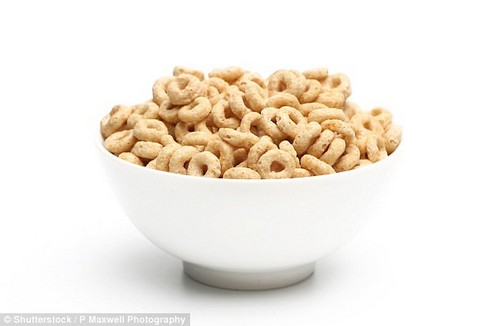As healthy-eating trends upward in America, the cereal industry has made efforts to keep up, with the industry’s sales remaining nearly static so far this year, compared to 2016.
Honey Nut Cheerios are marketed as ‘part of a heart-healthy eating plan’ on General Mills’s website, and are meant to be a tastier, but still relatively healthy alternative to regular, oat-y tasting Cheerios, making them more attractive to children.
However, standard serving-size bowl (about three quarters of a cup) of Honey Nut Cheerios has nine grams of sugar, which is more than one third of the daily total of 25 grams of sugar the American Heart Association recommends for children.
‘America’s favorite cereal,’ Honey Nut Cheerios has been seen as a part of a healthy breakfast since it was introduced in 1979. But the cereal may not be as healthy as it’s cracked up to be
Oats, the main and namesake ingredient in the General Mills’s Cheerios cereal, are a fairly well-balanced source of nutrition. Raw oats, are about 66 percent carbohydrates, 15 percent fiber, seven percent fat, and only about 1.5 percent sugar.
But added sugar contents of cereals have been creeping steadily up since cereal became ‘part of a complete breakfast,’ as so many cereal commercials have said.
Cereal has a robust – if not rich – history in America. Early settlers found that barley and oats grew easily in North American soil. When German immigrant Ferdinand Schumacher introduced his oat grinder in 1854, Americans began to turn toward warm oatmeal for breakfast. Thus was born the Quaker Oats brand.
Cold cereal got off to a rockier start. The first version in the US had to be soaked overnight, and the necessary trouble deterred busy Americans.
But all it took was a box for cereal to gain popularity.
Cereal sold in a box was introduced in the late 1870s, and was far cleaner and more convenient than cooking oat cereal. Plus, the box offered the opportunity for advertising, which has sense become the bread and butter of cereal and milk.
Busy adults liked it for being quick to shovel down before work, but packaging – and eventually radio and TV – presented an opportunity to market cereal to a new demographic: children.
Around the same time, cereal companies branding themselves with mascots, Post added a sugar-coating to its own product, and the original Cheeerios – then called CheeriOats – came onto the market.

Size DOES matter. Honey Nut Cheerios changed its serving size from a full cup to three quarters of a cup in 2011. Now, the serving contains 9 grams of sugar, but if the serving were still a full cup, it would contain 12 grams of sugar
In 1942, Kellog’s started putting pins with military squadron insignia into its cereal boxes, giving way to the rise of the cereal box prizes, and the dawn of cereal nostalgia.
As the podcast Part-Time Genius put it in their episode on cereal nostalgia, cereal prizes were beloved by Baby Boomers, who passed that love down to their children, who passed it down to theirs, all the way through the peak of cereal sales, around 1996.
Honey Nut Cheerios was introduced in 1979 as a sweeter spin on the original Cheerios. Its sugar content crept up, until General Mills announced in 2009 that it was going to lower the sugar content in all of its cereals for children, following a lawsuit over its ‘Cheerios Protein’ offshoot.
Amy Shapiro, nutritionist

Now, there are nine grams of sugar, rather than 11, in one three-quarter cup of Honey Nut Cheerios. But the serving size went down – from a full cup – with the sugar content.
If the serving size were still one cup, there would be 12 grams of sugar in a serving of Honey Nut Cheerios – more sweetener than it contained in 2009.
Still, to most people, ‘Honey Nut Cheerios seem to be healthy, because original Cheerios are pretty healthy,’ says Amy Shapiro, a New York City nutritionist.
Shapiro recommends that cereals and breakfast foods should not contain more than eight grams of sugar.
Cheerios’ website shows the current packaging and nutritional facts for Honey Nut Cheerios. The cereal contains several added sweeteners: regular and brown sugar, honey and syrup
She says that as cereals go, neither Cheerios variety is ‘the worst,’ but the bigger problem is portion control.
‘Most adults are not going to eat just one bowl,’ she says. ‘I don’t usually recommend cereals because people like them too much and cereal will spike your blood sugar.’
The sugar infusion means that cereal is not a very satisfying meal, and people just want to eat again soon after the finish their bowl – or bowls – of cereal.
‘Cereal brings you back to childhood, it’s almost like a comfort food,’ says Shapiro, ‘but most of my clients say they can’t keep it at home because they eat too much or want to eat later,’ says Shapiro.
She says that plain cereals like original Cheerios are okay because their relatively high fiber contents slow digestion, and ‘the slower you digest it, the less intense the blood sugar crash is.’
Shapiro says that if you must have cereal, use it as an ‘added crunch factor’ to greek yogurt, or use whole milk and some chia seeds and fruit.



